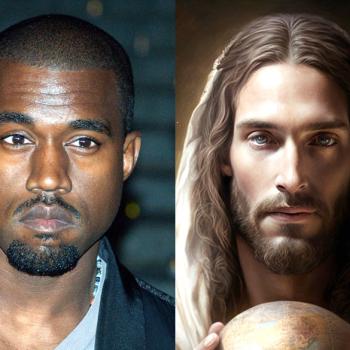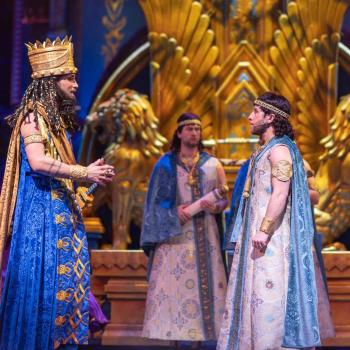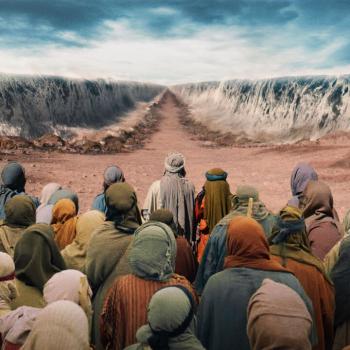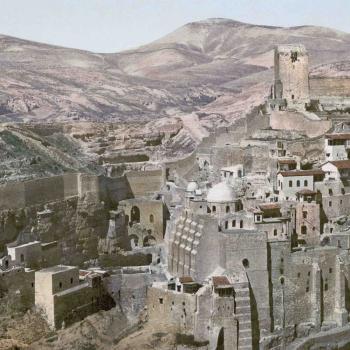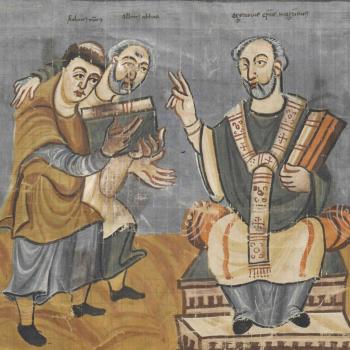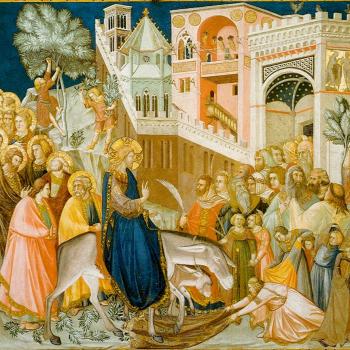No, whatever the title suggests, that is not the name of a forthcoming novel from Neil Gaiman.
The Book of the Giants is an ancient Jewish text, part of the pseudepigrapha, the “falsely titled” writings usually attributed to some ancient sage or prophet. Although it is not well known by non-specialists, the Book of the Giants actually tells us a great deal about ancient literary cultures, and the emergence of the spiritual universe that we see in Christianity, Gnosticism, Manicheanism and other traditions. (I will throughout be using the fine summary by James R. Davila). In this post, I will introduce the Book, and then, next time, suggest why it matters so much.
To explain what the Book is and why it matters requires a little background. I have posted several times on the Book of 1 Enoch, which had an immense influence on the sect at Qumran, and later on early Christianity. 1 Enoch as we have it today is a very substantial work that scholars see as an anthology of writings that were originally separate. Usually, they identify five components, including the Book of the Watchers, the Parables, the Astronomical Book, the Dream Visions, and the Epistle of Enoch. For present purposes, I will focus on the Book of the Watchers, which tells how fallen angels came down to earth and married human women, spawning a monstrous race called the Nephilim – roughly, the Giants of our Book of that name. Those events then provoke the great Flood, and the career of Noah. (The now-lost Book of Noah is a major source for these stories).
That all brings us (eventually) to the Book of the Giants. Through the centuries, a text of this name had been known by name only. In the sixth century AD, the Gelasian Decree named and banned “the book about Og [Ogia] the giant, of whom the heretics assert that after the deluge he fought with the dragon.” We now know that this must refer to our Book of the Giants, which was also a standard text of the Manicheans – of whom more shortly. Versions of the book, thoroughly rewritten in Manichean guise, circulated across the Mediterranean world and deep into Asia. It was known in Syriac, Greek, Latin, Middle Persian, Parthian, Old Turkic, Coptic, Sogdian, Uyghur, and Arabic. That suggests what we might today call an international best-seller. The great scholar of Persia W. B. Henning published a collection of some of the Manichean work’s fragments as far back as 1943.
In modern times, though, Aramaic fragments of the work were discovered among the Dead Sea Scrolls. This allows us to reconstruct portions of what was clearly a lengthy and gruesomely detailed original work, but much of the narrative remains uncertain. What we can say confidently, though, is that the text has a close relationship to the material that we now find in 1 Enoch. Perhaps it relied on an already pre-existing collection like 1 Enoch, or else it might once have been independent. Arguably, it represents a free-standing text that should, logically, have been integrated into the anthology that we now call 1 Enoch, but for whatever reason of conviction or convenience, it was not. However we trace the direction of influence, it thus looks like a lost “sixth book” of that (now) five book collection.
As it stands, the Book of the Giants tells the standard Enochian story of the descent of the angels and the birth of the giants, focusing on such leaders as Ohyah/Ogias/Sahm, Mahaway, and Hahyah (The spelling of all these names varies widely in different texts). In the Qumran version, we meet the giants as they have dream visions of the coming Flood.
Throughout, the work focuses on dreams:
The two giants Ohyah and Hahyah have dreams. Hahyah describes his in the assembly of the giants. He dreamed of gardeners watering a garden which produced great shoots. But a disaster of some sort destroyed the garden in a deluge of water and fire. The other giants are unable to interpret his dream. Hahyah proposes that they consult Enoch for an interpretation.
And so on.
They have interactions with Enoch, and much of the action involves writing tablets that are lost and rediscovered, works by Enoch himself.
The scribe [Enoch . . . ] [ . . . ] copy of the second tablet that [Epoch] se[nt . . . ]in the very handwriting of Enoch the noted scribe [ . . . In the name of God the great] and holy one, to Shemihaza and all [his companions . . . ] 1et it be known to you that not [ . . . ] and the things you have done, and that your wives [ . . . ] they and their sons and the wives of [their sons . . . ] by your licentiousness on the earth, and there has been upon you [ . . . and the land is crying out] and complaining about you and the deeds of your children [ . . . ] the harm that you have done to it. [ . . . ] until Raphael arrives, behold, destruction [is coming, a great flood, and it will destroy all living things] and whatever is in the deserts and the seas. And the meaning of the matter [ . . . ] upon you for evil. But now, loosen the bonds bi[nding you to evil . . . ] and pray. (4Q530)
The Manichean versions feature many miscellaneous stories and events, many of which can be reconstructed, albeit very dubiously. Here for instance is one Middle Persian fragment from Henning:
. . . hard . . . arrow . . . bow, he that . . . Sām said: “Blessed be . . . had [he ?] seen this, he would not have died.” Then Shahmīzād said to Sām, his [son]: “All that Māhawai . . ., is spoilt (?).” Thereupon he said to . . . “We are . . . until . . . and . . . . . . that are in (?) the fiery hell (?) . . . As my father, Virōgdād, was . . .” Shahmīzād said: “It is true what he says. He says one of thousands. For one of thousands . . . .”. Sām thereupon began . . . Māhawai, too, in many places . . . until to that place he might escape and . . .
Or to take another passage, see for instance this valiant effort at reconstruction by Davila:
The giant Hobabiš (=Humbaba) robs someone of his wife. The giants fall out among themselves and begin killing one another and other creatures. Sa(h)m and his brother are mentioned. It appears that Sa(h)m has a dream in which a tablet was thrown in the water. It seems to have borne three signs, portending woe, flight, and destruction. Nariman has a dream about a garden full of trees in rows. Two hundred of something, perhaps trees, are mentioned.
We note all the uncertainties – “somebody” does this, “It appears that” something happens, perhaps they are trees…..
The Manichean book ends with an apocalyptic battle:
Ohyah (or Ahyah), the primordial monster Leviathan, and the archangel Raphael engage in a great battle, “and they vanished.” According to one tradition, Ohyah survived the Flood and fought this battle after it.
Although dating the work is very difficult, its presence at Qumran means that it likely precedes the Christian era, and a third or second century BC date is reasonable. Of course, the fact that a work was found at Qumran does not mean that it was written there, nor that it was directly associated with the sect that lived at that place. As Davila says, though, that Qumran element allows us to say that the work must be Jewish in origin, because specifically Jewish themes are otherwise not obvious.
Much of the content draws on Mesopotamian ideas, and two of the evil giants in the Aramaic version are named Gilgamesh and Hunbabis. These recall the leading figures of the famous Epic of Gilgamesh, including the hero himself, and the monster he slays. Some scholars see the treatment of Gilgamesh here as a deliberate Jewish flouting of pagan myth, but that is controversial.
With all the gaps and uncertainties, we thus have a reasonable idea of what the Book of the Giants was, and the story it told. Next time I will suggest why it is so significant.




